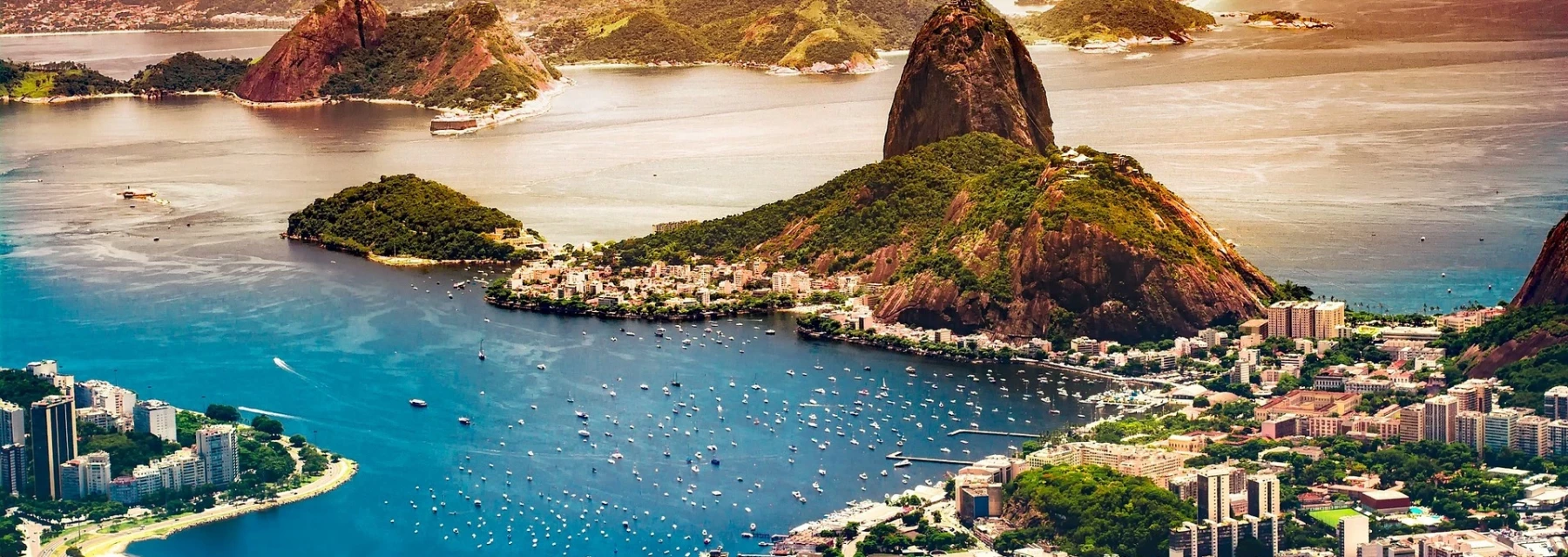The 14 essential things to do in Rio de Janeiro
Last update : 26/05/2024 15:41Summary
- To visit
-
- 1 - Christ the Redeemer (Cristo Redentor)
- 2 - Sugar Loaf (Pão de Açúcar)
- 3 - Copacabana and Ipanema beaches
- 4 - Botanical Garden (Jardim Botânico)
- 5 - Escadaria Selarón
- 6 - Maracana Stadium
- 7 - Samba Festival (Rio Carnival)
- 8 - Visit to the Santa Teresa neighborhood
- 9 - Niterói Museum of Contemporary Art (MAC)
- 10 - Hiking in the Tijuca Forest
- 11 - Visit to the Feira de São Cristóvão Flea Market
- 12 - Cruise in Guanabara Bay
- 13 - Visit to the favela community of Rocinha
- 14 - Carioca Nightlife Experience
- Rio de Janeiro - Where to Stay?
- Rio de Janeiro - How to get around?
- Rio de Janeiro - Best period
Rio de Janeiro, commonly referred to simply as Rio, is a vibrant city located in southeastern Brazil. It is renowned for its stunning natural landscapes, including its famous beaches like Copacabana and Ipanema, as well as the iconic Christ the Redeemer statue atop Corcovado Mountain.
Rio de Janeiro was the capital of Brazil until 1960, when Brasília took over that role. However, it remains one of Brazil's most culturally significant cities and a major tourist destination.
Some highlights of Rio de Janeiro include:
-
Christ the Redeemer: This massive statue of Jesus Christ stands atop the 700-meter Corcovado Mountain and offers panoramic views of the city.
-
Copacabana Beach: One of the most famous beaches in the world, Copacabana is known for its lively atmosphere, white sand, and iconic promenade.
-
Ipanema Beach: Another popular beach in Rio, Ipanema is famous for its beauty, surfing, and vibrant nightlife.
-
Sugarloaf Mountain: A granite peak rising 396 meters above the harbor, offering breathtaking views of the city and Guanabara Bay.
-
Tijuca National Park: One of the largest urban rainforests in the world, located within the city limits of Rio de Janeiro. It's a haven for wildlife and offers numerous hiking trails and waterfalls.
-
Samba: Rio is the birthplace of samba, and visitors can experience this vibrant music and dance style at various clubs and during the city's famous Carnival celebrations.
-
Carnival: Speaking of which, Rio de Janeiro hosts one of the largest and most famous Carnival celebrations in the world, attracting millions of visitors each year with its elaborate parades, costumes, and samba competitions.
-
Maracanã Stadium: One of the most iconic soccer stadiums globally, Maracanã has hosted numerous historic matches and events.
Despite its beauty and cultural significance, Rio de Janeiro also faces challenges such as poverty, crime, and environmental issues. However, efforts are continually made to address these issues while celebrating the city's rich heritage and natural beauty.
1 - Christ the Redeemer (Cristo Redentor)
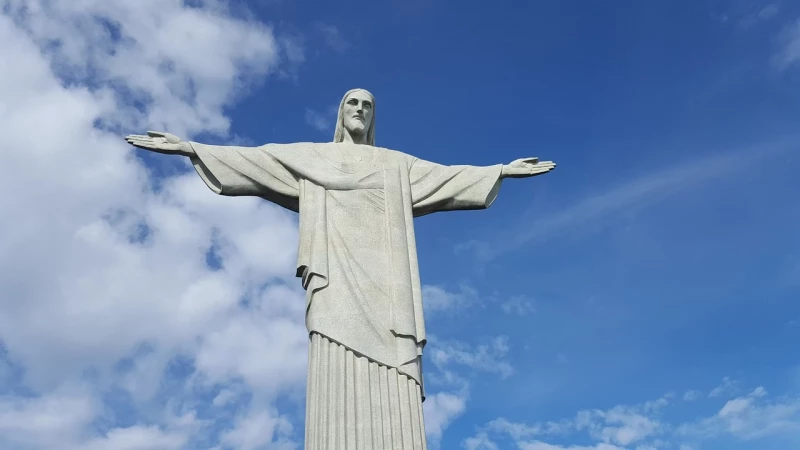
Christ Rédempteur, also known as Cristo Redentor, is a famous statue located in Rio de Janeiro, Brazil. It stands atop the Corcovado mountain, overlooking the vibrant city below. The statue depicts Jesus Christ with outstretched arms, symbolizing his role as a redeemer.
Constructed between 1922 and 1931, Christ Rédempteur is made of reinforced concrete and soapstone, and it reaches a height of approximately 30 meters (98 feet), including its pedestal. It has become an iconic symbol of both Rio de Janeiro and Brazil as a whole, attracting millions of visitors from around the world each year.
The statue was designed by Brazilian engineer Heitor da Silva Costa and sculpted by French-Polish sculptor Paul Landowski. It is considered one of the largest Art Deco statues in the world and has been listed as one of the New Seven Wonders of the World.
In addition to its religious significance, Christ Rédempteur is also a symbol of peace and unity, serving as a reminder of the diverse cultural heritage and natural beauty of Brazil.
 Our tips for getting the most out of your experience.
Our tips for getting the most out of your experience.
If you're planning to visit Christ the Redeemer in Rio de Janeiro, here are some tips to make your experience more enjoyable:
-
Choose the right time of day: The busiest hours are typically midday. To avoid crowds, consider visiting early in the morning or late in the afternoon.
-
Book your tickets in advance: It's recommended to book your tickets for Christ the Redeemer in advance, especially if you're visiting during the peak tourist season. This will save you from waiting in long lines at the ticket office.
-
Use the train or van to access the summit: You can reach the top of Corcovado by taking the scenic train or by using a van. Both options offer stunning views of the city.
-
Be prepared for the weather: The summit of Corcovado can be windy and cool, even on warm days below. Make sure to bring appropriate clothing, including a light jacket or sweater.
-
Bring water and snacks: It's always a good idea to have water and snacks with you, especially if you plan to spend some time exploring around Christ the Redeemer.
-
Take advantage of the viewpoints: Once at the top, take the time to admire the panoramic view of Rio de Janeiro and its surroundings. Make sure to capture some memorable photos!
-
Respect the environment: Be sure to follow the park rules and leave no trash behind. Help preserve this unique natural environment.
By following these tips, you'll be better prepared to fully enjoy your visit to Christ the Redeemer and make it an unforgettable experience in Rio de Janeiro.
2 - Sugar Loaf (Pão de Açúcar)
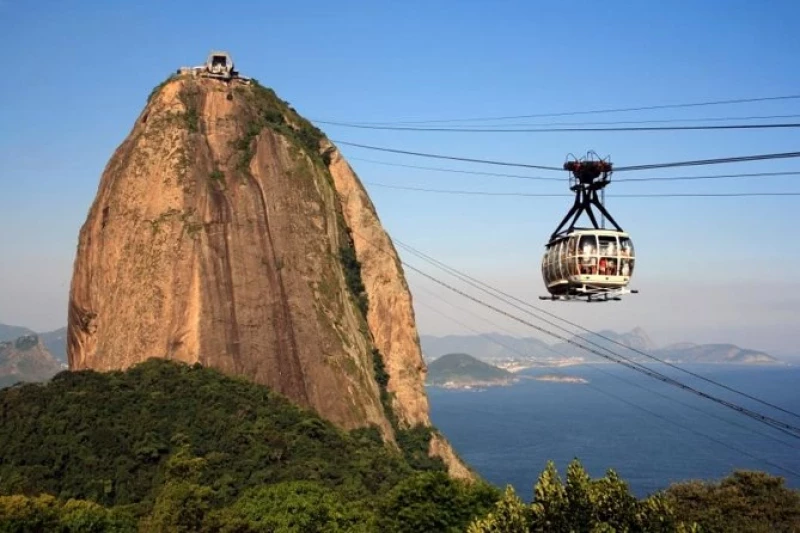
Pain de Sucre, which translates to "Sugarloaf" in English, refers to a famous natural landmark found in Rio de Janeiro, Brazil. It is a peak rising 396 meters (1,299 feet) above the harbor and beaches of Rio de Janeiro. The name "Sugarloaf" comes from the traditional shape of concentrated refined loaf sugar, which it resembles.
The peak is a popular tourist attraction, offering stunning panoramic views of the city, including the beaches of Copacabana and Ipanema, as well as the Corcovado Mountain with the iconic Christ the Redeemer statue.
To reach the summit of Sugarloaf, visitors typically take a two-stage cable car ride. The first stage takes passengers to the top of Morro da Urca, a shorter peak adjacent to Sugarloaf, and the second stage ascends to the summit of Sugarloaf itself.
Pain de Sucre, or Sugarloaf, holds cultural and historical significance for Rio de Janeiro and is one of the most recognizable symbols of the city, attracting tourists from around the world.
 Our tips for getting the most out of your experience.
Our tips for getting the most out of your experience.
Here are some tips for visiting Sugarloaf Mountain (Pão de Açúcar) in Rio de Janeiro:
-
Choose the right time: Try to visit Sugarloaf Mountain early in the morning or late in the afternoon to avoid the intense midday heat and tourist crowds.
-
Buy tickets in advance: To skip the long queues, consider purchasing your cable car tickets in advance online or at an early ticket office.
-
Allocate enough time: Plan for at least half a day for your visit to fully enjoy the panoramic views and explore the hiking trails around Sugarloaf Mountain.
-
Bring water and snacks: Make sure to bring plenty of water and light snacks, especially if you plan on hiking or exploring the surroundings.
-
Wear appropriate clothing: Dress in lightweight, comfortable clothing and wear suitable walking shoes if you intend to hike.
-
Enjoy the view: Take your time to admire the spectacular panoramic views of Rio de Janeiro from the top of Sugarloaf Mountain, and be sure to bring a camera to capture these memorable moments.
-
Explore the surroundings: Take advantage of your visit to explore the nearby hiking trails and attractions, such as Vermelha Beach and Tijuca Forest Park.
By following these tips, you'll be able to make the most of your visit to Sugarloaf Mountain in Rio de Janeiro.
3 - Copacabana and Ipanema beaches
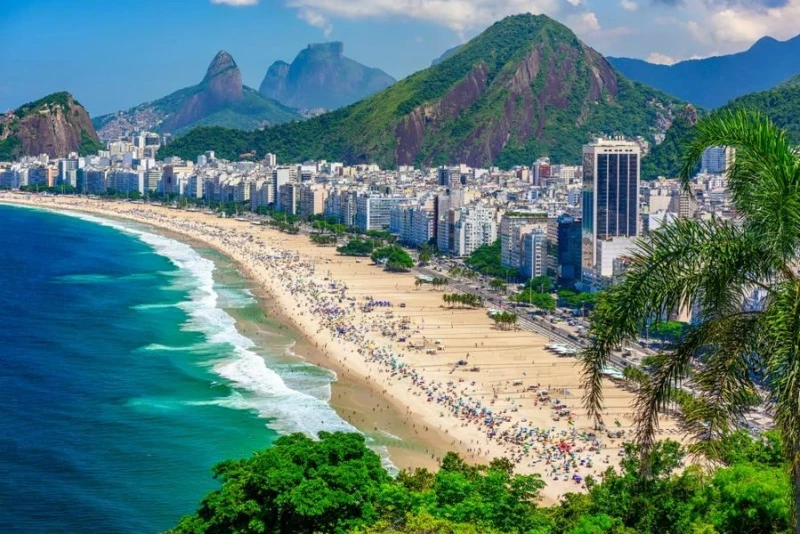
The Copacabana and Ipanema beaches are two of the most famous beaches in Rio de Janeiro, Brazil, and even worldwide.
Copacabana:
- Copacabana is an iconic beach that stretches for about 4.5 km along the coast of Rio de Janeiro.
- It is famous for its golden sand, clear water, and waves suitable for swimming and water sports.
- The beach is bordered by a paved promenade called "Avenida Atlântica," where you can find hotels, restaurants, bars, and kiosks selling refreshments.
- Copacabana attracts crowds of tourists and locals, especially during weekends and holidays.
Ipanema:
- Located right next to Copacabana, Ipanema Beach is also very popular and has a slightly different vibe.
- Ipanema is renowned for its fine sand, calm waters, and views of the surrounding mountains, including the famous Dois Irmãos (Two Brothers) mountain.
- Ipanema Beach is also famous for being the birthplace of the bossa nova cultural movement in the 1960s.
- Like Copacabana, Ipanema has a lively promenade lined with bars, restaurants, and shops.
- Visitors can also enjoy the spectacular sunset from the beach.
These two beaches are icons of Rio de Janeiro and offer an unforgettable experience for those who visit, whether it's relaxing in the sun, engaging in water sports, or simply soaking in the lively atmosphere of the city.
 Our tips for getting the most out of your experience.
Our tips for getting the most out of your experience.
Here are some tips for visiting Copacabana and Ipanema beaches:
-
Safety: Keep an eye on your belongings at all times. Beaches can be crowded and attract pickpockets.
-
Sun Protection: Remember to apply sunscreen regularly as the sun can be very strong, especially during the summer months.
-
Clothing and Equipment: Bring lightweight clothing, a hat, sunglasses, and a beach towel. If you plan to swim, make sure to have a swimsuit and, if necessary, snorkeling gear.
-
Hydration: It's important to stay hydrated, especially under the Brazilian sun. Bring bottled water or purchase cool drinks from the kiosks along the beach.
-
Water Activities: The beaches offer plenty of opportunities for water activities such as surfing, stand-up paddleboarding, beach volleyball, and more. Make sure to check safety conditions and rent equipment from reliable vendors.
-
Exploring Surroundings: In addition to enjoying the beach itself, take the time to explore the surrounding neighborhoods. Copacabana and Ipanema are full of shops, restaurants, bars, and cultural attractions.
-
Sunset: Watching the sunset from either of these beaches is an unforgettable experience. Arrive a bit early to find a good spot and enjoy the spectacle.
-
Transportation: Check transportation options to get to the beaches, especially if you're staying in a distant neighborhood. Taxis, ride-sharing apps, and public transportation are common ways to get around Rio de Janeiro.
By following these tips, you can fully enjoy your visit to Copacabana and Ipanema beaches while staying safe and making the most of your experience.
4 - Botanical Garden (Jardim Botânico)
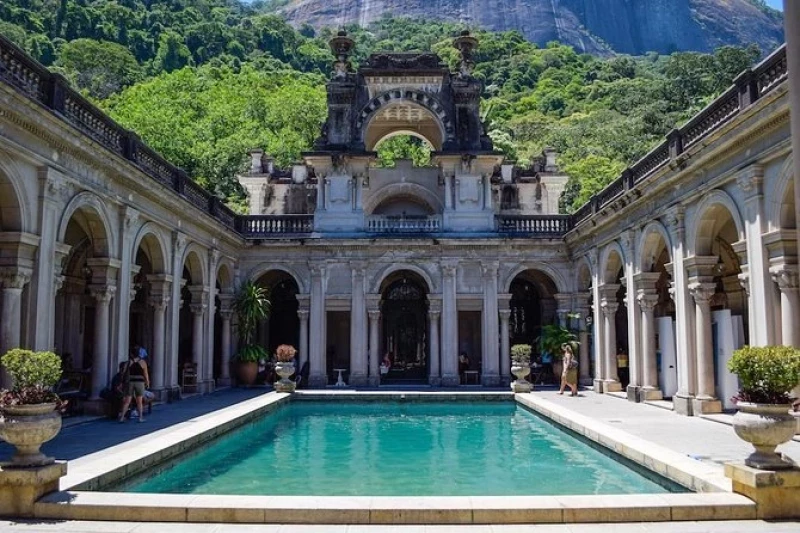
The Rio de Janeiro Botanical Garden is one of the most famous and impressive botanical gardens in the world. Located at the foot of the Corcovado Mountain, in the Jardim Botânico neighborhood, it houses an impressive collection of tropical and subtropical plants.
The garden was founded in 1808 by Prince Regent Dom João VI. It spans approximately 140 hectares and features over 6,500 species of plants, some of which are rare and endangered. Among its most famous attractions are greenhouses, ponds, picturesque trails, and an alley of imposing royal palm trees.
The Rio Botanical Garden is not only a place of natural beauty but also an important research center for the conservation of Brazilian flora. It attracts visitors from around the world who come to admire its exceptional biodiversity and enjoy its peaceful ambiance. Additionally, it is often used as a filming location for movies and series due to its picturesque beauty.
5 - Escadaria Selarón
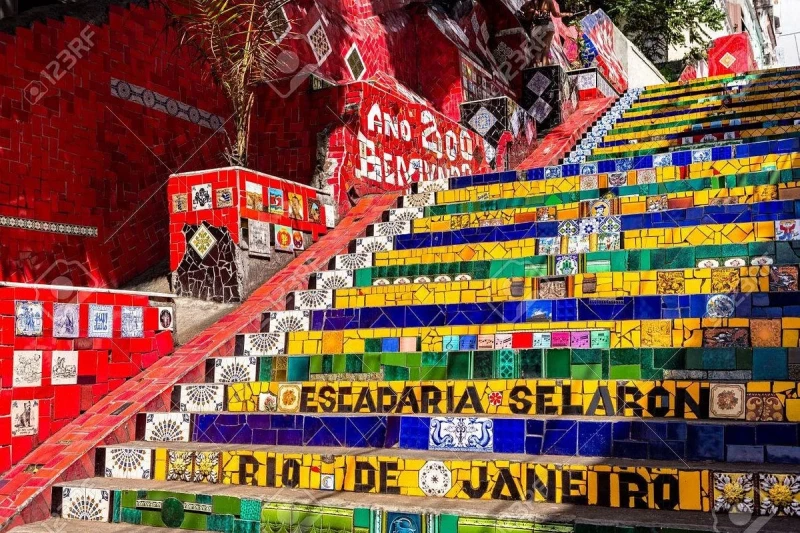
The Selarón Steps, located in Rio de Janeiro, are a vibrant and iconic staircase renowned for their colorful mosaic tiles. Created by Chilean-born artist Jorge Selarón, the steps are a tribute to the Brazilian people and culture. Selarón began decorating the steps in the late 1990s, using a combination of tiles, ceramics, and mirrors collected from around the world.
The staircase consists of 215 steps that connect the neighborhoods of Lapa and Santa Teresa. Each step is adorned with intricate and unique designs, forming a kaleidoscope of colors that captivate visitors. The project was a labor of love for Selarón, who devoted himself to the ongoing maintenance and expansion of the staircase until his death in 2013.
The Selarón Steps have become a popular tourist attraction, drawing visitors from around the globe to marvel at their beauty and significance. They have also been featured in numerous films, music videos, and advertisements, further cementing their status as a cultural landmark in Rio de Janeiro.
6 - Maracana Stadium
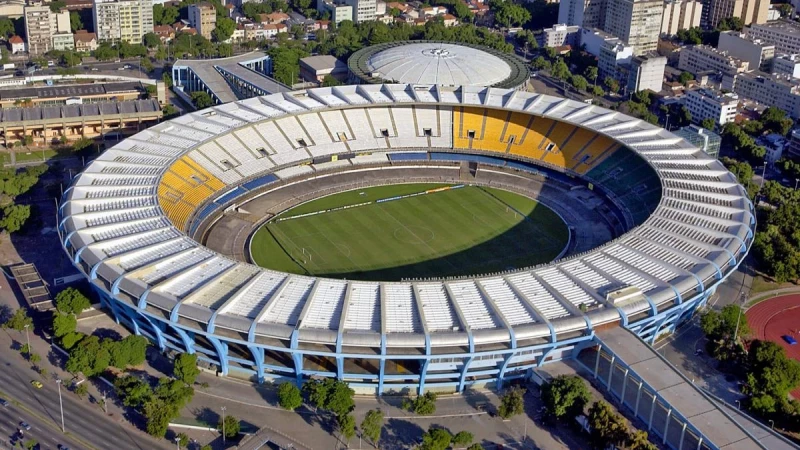
The Maracanã Stadium, located in Rio de Janeiro, is one of the most famous and iconic football stadiums in the world. Inaugurated in 1950 for that year's FIFA World Cup, it has a rich history and has hosted numerous major sporting and cultural events.
The stadium is situated in the Maracanã neighborhood, from which it takes its name, and can accommodate up to approximately 78,000 spectators. It has been the stage for historic football moments, including the 1950 FIFA World Cup final, as well as numerous club matches and legendary concerts.
Following major renovations in preparation for the 2014 FIFA World Cup and the 2016 Summer Olympics, the stadium has become a showcase of modern and sustainable architecture while preserving its historical heritage.
The Maracanã Stadium remains an iconic venue in Rio de Janeiro, attracting enthusiastic crowds for major sporting events and musical performances, while also remaining an important cultural and sporting symbol for Brazil and the world.
7 - Samba Festival (Rio Carnival)
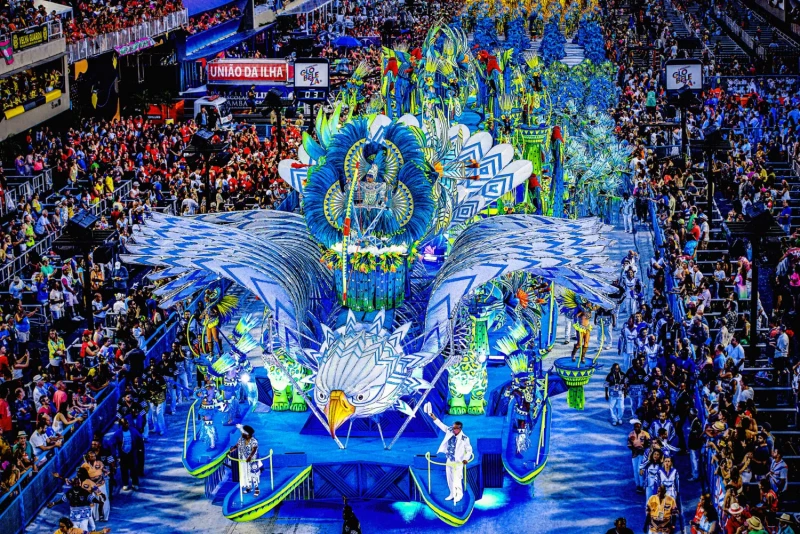
The Samba Parade is an essential part of the Rio de Janeiro Carnival in Brazil. It is often considered one of the most vibrant and festive moments of this annual event. Samba, which is both a musical genre and a dance, lies at the heart of this celebration.
The Samba Parade typically features parades by samba groups, known as "samba schools," who compete for the title of Carnival champion. These samba schools put considerable effort into preparing their performances, which involve colorful parades with allegorical floats, extravagant costumes, and mesmerizing dances.
Thousands of dancers, singers, and musicians participate in these parades, representing each samba school. The schools vie to impress the judges and win the coveted title of Carnival champion.
The Samba Parade is also an opportunity for residents and visitors of Rio de Janeiro to join in the celebration by dancing in the streets, listening to live music, and enjoying the festive atmosphere that permeates the entire city during Carnival.
This iconic event reflects the significance of samba in Brazilian culture and attracts spectators from around the world who come to experience the energy and passion of the Rio de Janeiro Carnival.
 Our tips for getting the most out of your experience.
Our tips for getting the most out of your experience.
Participating in the Rio Carnival can be an incredible and memorable experience. Here are some tips to make the most out of your experience:
-
Plan ahead: The Rio Carnival is a highly popular event, and accommodations, event tickets, and activities can sell out quickly. Make sure to book your tickets and accommodation well in advance.
-
Choose your events wisely: The Rio Carnival lasts for several days and offers a variety of events, from samba parades to dance parties. Choose the events that interest you the most and purchase your tickets in advance if necessary.
-
Wear comfortable, lightweight clothing: Temperatures in Rio during Carnival can be high, so dress accordingly. Opt for lightweight, comfortable clothing, and wear walking shoes to easily navigate through the crowds.
-
Stay safe: Be sure to remain vigilant and aware of your surroundings, especially in crowded areas. Avoid carrying valuables and keep an eye on your personal belongings at all times.
-
Stay hydrated and protect your skin: It's important to stay hydrated throughout the day, especially if you're out in the sun. Bring a reusable water bottle and protect your skin with sunscreen.
-
Be ready to dance: The Rio Carnival is synonymous with music and dance. Let yourself be swept away by the contagious energy and be prepared to dance to the rhythm of samba with locals and fellow participants.
-
Respect the local culture: Make sure to respect local traditions and culture during the Carnival. Be open-minded and willing to learn and participate in this unique celebration.
By following these tips, you'll be ready to have an unforgettable experience at the Rio Carnival. Enjoy the festivities and immerse yourself in the lively atmosphere of this spectacular event!
8 - Visit to the Santa Teresa neighborhood
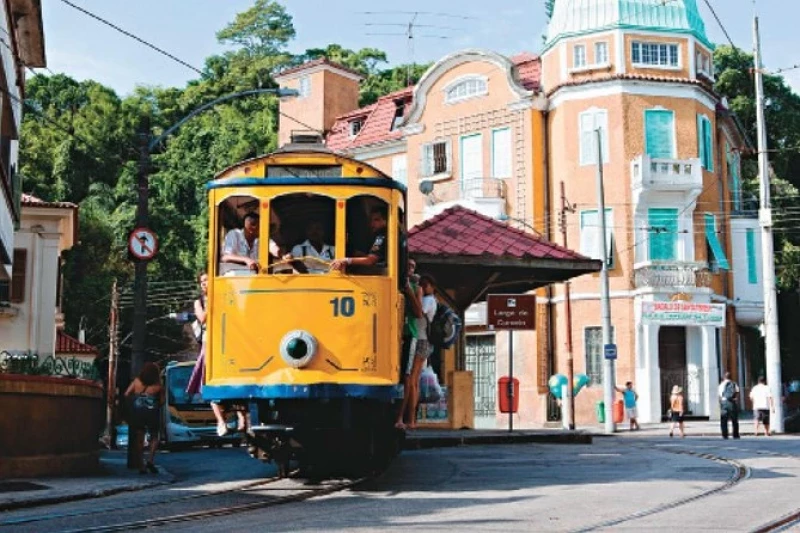
The neighborhood of Santa Teresa is a historic district located in the city of Rio de Janeiro, Brazil. It's known for its bohemian charm, cobblestone streets, colorful houses, and numerous artisan shops, bars, restaurants, and art galleries. Santa Teresa is also famous for its panoramic views of the city, particularly from the iconic bondinho (tram) that ascends the hill to the neighborhood. It's a popular spot both for Rio residents and tourists seeking an artistic atmosphere and a glimpse into the history and culture of the city.
 Our tips for getting the most out of your experience.
Our tips for getting the most out of your experience.
If you're planning to visit the Santa Teresa neighborhood in Rio de Janeiro, here are some useful tips:
-
Transportation: The most picturesque way to get to Santa Teresa is by taking the bondinho (tram) from downtown. Make sure to check the schedule in advance, as the service can sometimes be irregular.
-
Explore on foot: Santa Teresa is a neighborhood that's perfect for exploring on foot. Allow plenty of time to wander through the cobblestone streets and discover the many shops, cafes, and art galleries.
-
Map or app: To avoid getting lost in the winding alleys, use a map or navigation app on your phone to help you navigate.
-
Stay vigilant: While Santa Teresa is generally safe during the day, it's advisable to remain vigilant, especially at night. Avoid deserted streets and keep an eye on your belongings.
-
Take photos: Don't miss the opportunity to capture the stunning views of the city from Santa Teresa's mirantes (viewpoints). It's a great spot for memorable photos.
-
Sample local cuisine: Enjoy the laid-back atmosphere of Santa Teresa by stopping at one of the neighborhood's many restaurants or bars to sample delicious Brazilian dishes and refreshing drinks.
-
Explore nearby attractions: Santa Teresa is close to several popular attractions in Rio de Janeiro, such as the bohemian neighborhood of Lapa and the famous Escadaria Selarón (Selaron Steps). Take advantage of this proximity to explore these nearby places during your visit.
By following these tips, you'll be able to fully enjoy your visit to the charming Santa Teresa neighborhood in Rio de Janeiro.
9 - Niterói Museum of Contemporary Art (MAC)
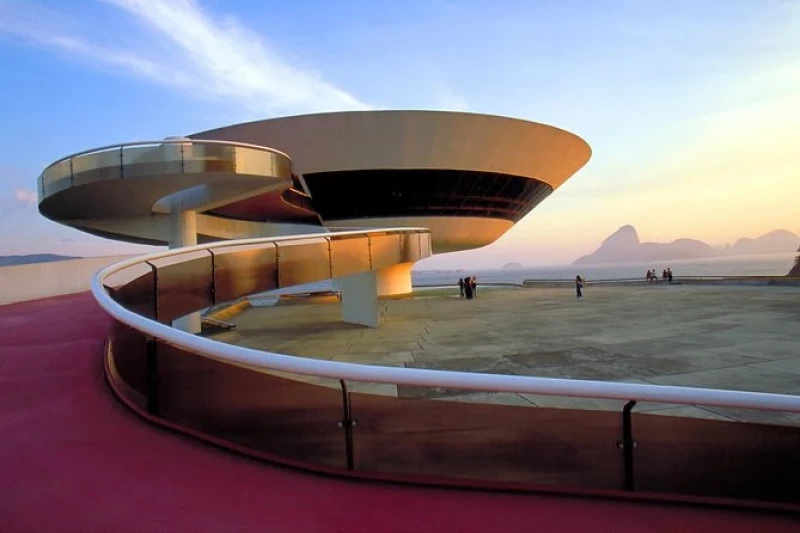
The Museum of Contemporary Art in Niterói (MAC), located in Niterói, Rio de Janeiro, Brazil, is an architectural and cultural icon. Designed by Brazilian architect Oscar Niemeyer, the museum is famous for its futuristic design resembling a flying saucer hovering above the ground. Inaugurated in 1996, the MAC houses a collection of contemporary artworks, including paintings, sculptures, photographs, and installations.
The building itself is a work of art, with its bold curves and panoramic windows offering stunning views of Guanabara Bay and the city of Rio de Janeiro in the background. The MAC has become a must-visit destination for art enthusiasts and tourists from around the world, drawn to its unique architecture and dynamic exhibitions.
In addition to its permanent collection, the MAC regularly hosts temporary exhibitions featuring emerging and established Brazilian and international artists. The museum also offers educational programs and cultural events to encourage interaction and engagement with contemporary art.
In summary, the Museum of Contemporary Art in Niterói is not only an important cultural institution in Brazil but also an iconic architectural masterpiece that embodies the aesthetic and creative spirit of its creator, Oscar Niemeyer.
10 - Hiking in the Tijuca Forest
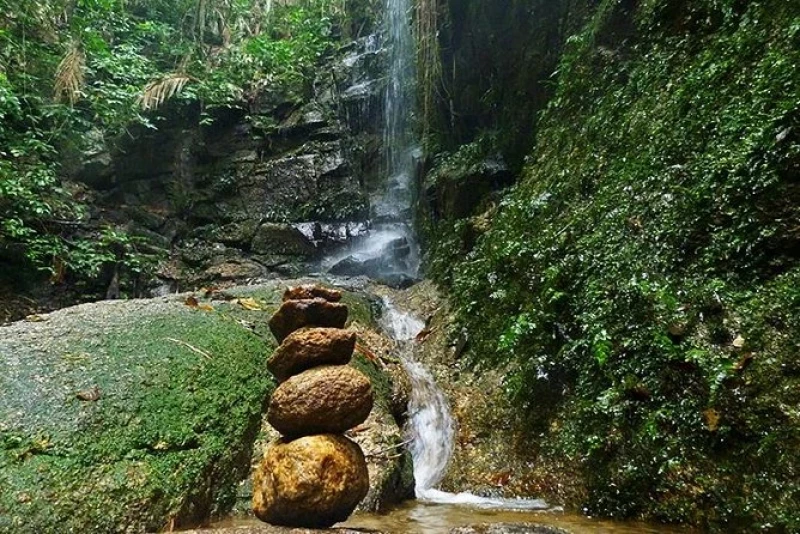
The Tijuca Forest is a tropical forest located in the city of Rio de Janeiro, Brazil. It is renowned for being the largest urban forest in the world, covering an area of approximately 39 square kilometers. Tijuca Forest is a Brazilian national park and is a popular tourist destination for both locals from Rio and international visitors.
Tijuca Forest is known for its exceptional biodiversity, housing numerous plant and animal species, some of which are endemic to the region. Among the forest's most popular attractions are Tijuca Peak, which offers panoramic views of the city of Rio de Janeiro, as well as Cascatinha Taunay waterfall and the Christ the Redeemer statue, a famous landmark overlooking the city from the summit of Corcovado Mountain, located within Tijuca Forest.
The Tijuca Forest is also a popular spot for hiking, mountain biking, and other outdoor activities. It provides visitors with the opportunity to explore Brazil's lush nature while still being close to the urban center of Rio de Janeiro.
 Our tips for getting the most out of your experience.
Our tips for getting the most out of your experience.
Here are some tips for hiking in Tijuca Forest:
-
Physical Preparation and Proper Gear: Ensure you are physically prepared for hiking, especially if tackling more challenging trails. Wear comfortable hiking shoes, appropriate clothing, and bring an adequate supply of water.
-
Choose Trails Suited to Your Level: Tijuca Forest offers a variety of trails suitable for different skill levels. Select ones that match your fitness level and hiking experience.
-
Research Trails and Get a Map: Before heading out, research available trails and obtain a map of the park. This will help you plan your route and avoid getting lost.
-
Start Early: It's recommended to start your hike early in the morning to avoid the intense heat of the afternoon and to have enough time to explore the trails.
-
Respect Nature: Respect the natural environment by leaving no trace of your visit. Pack out your trash and stay on designated trails to avoid disturbing local wildlife and flora.
-
Be Aware of Potential Hazards: Familiarize yourself with potential natural hazards in the area, such as snakes, stinging insects, or changing weather conditions. Be prepared to handle these situations if they arise.
-
Hike in Groups if Possible: If possible, hike in groups for safety reasons. This can be helpful in case of emergencies or if you need assistance on the trail.
By following these tips, you can fully enjoy your hiking experience in the beautiful Tijuca Forest while ensuring your safety and respecting the natural environment.
11 - Visit to the Feira de São Cristóvão Flea Market
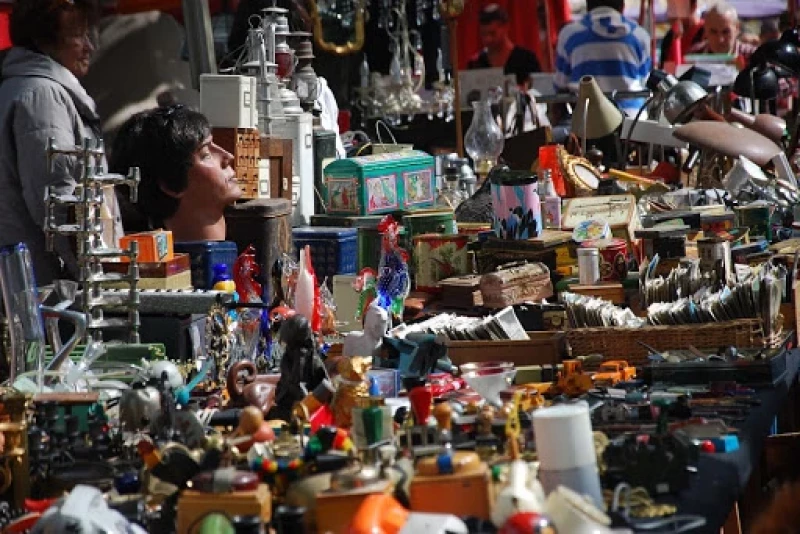
The Feira de São Cristóvão flea market is one of the largest and liveliest open-air markets in Rio de Janeiro, Brazil. It is located in the São Cristóvão neighborhood in the northern part of the city.
The market is primarily known for its cultural diversity, particularly its representation of the Northeastern Brazilian culture. You can find a variety of items ranging from traditional clothing and handicrafts to typical food products from the region, such as dried beef (charque), manioc flour (farinha), coconut sweets (cocadas), and much more.
In addition to the sales stalls, the market often features live musical performances showcasing traditional Northeastern Brazilian genres like forró, xaxado, and baião. It's a very popular spot for locals and tourists alike who want to experience the cultural richness of Brazil, particularly from the Northeast region.
The Feira de São Cristóvão flea market is typically open on weekends and holidays, and it often attracts a lively crowd looking to enjoy the festive atmosphere and the variety of products on offer. It's an ideal place to sample regional cuisine, purchase unique souvenirs, and immerse yourself in Brazilian music and dance.
12 - Cruise in Guanabara Bay
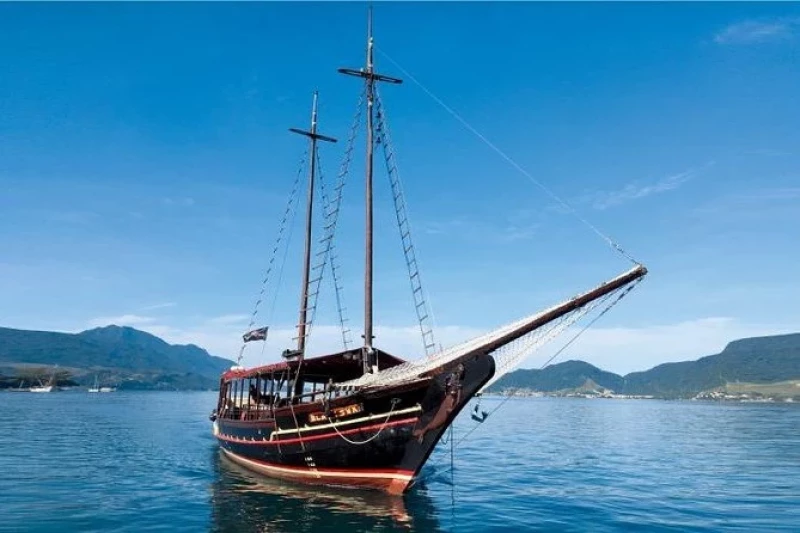
A cruise in the Guanabara Bay offers a stunning perspective of Rio de Janeiro's iconic landscape from the water. Guanabara Bay is a picturesque inlet located on the southeastern coast of Brazil, surrounded by the city of Rio de Janeiro.
During the cruise, passengers typically have the opportunity to admire famous landmarks such as Sugarloaf Mountain (Pão de Açúcar), the Christ the Redeemer statue (Cristo Redentor), and the lush greenery of the surrounding hillsides. The bay is also dotted with smaller islands, some of which are historic sites or nature reserves, adding to the scenic beauty of the area.
Many cruises offer onboard entertainment, including live music, as well as opportunities for dining and refreshments. Some cruises may also include stops at certain points of interest along the bay, allowing passengers to disembark and explore.
Overall, a cruise in the Guanabara Bay provides a memorable and relaxing way to take in the breathtaking views of Rio de Janeiro's coastline and landmarks while enjoying the gentle sway of the water. It's a must-do experience for visitors to the city looking to appreciate its beauty from a different perspective.
13 - Visit to the favela community of Rocinha
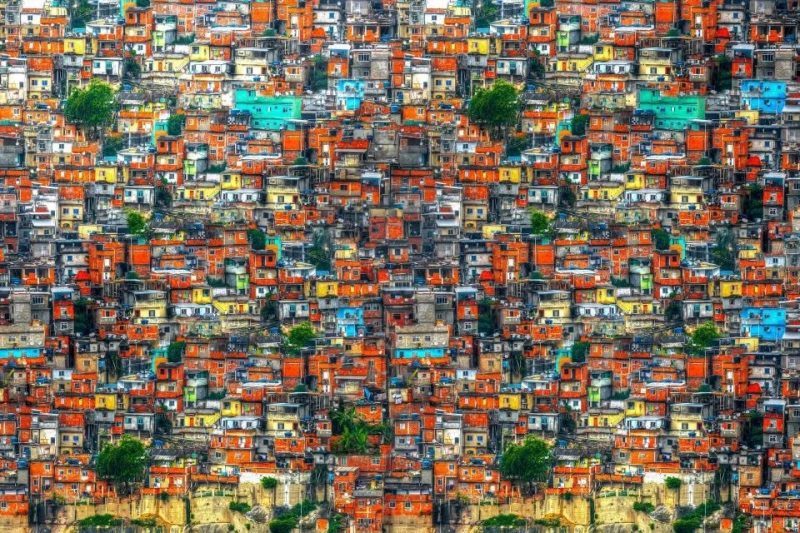
Visiting the Rocinha favela offers a unique opportunity to gain insight into one of Rio de Janeiro's largest and most well-known informal settlements. Located on a hillside between the neighborhoods of São Conrado and Gávea, Rocinha is home to a diverse and vibrant population.
Many tour agencies offer guided tours of Rocinha, led by local guides who are residents of the favela themselves. This provides visitors with authentic perspectives and allows them to ask questions about life in the favela.
During the tour, participants often explore the narrow and winding streets of the favela, observe local activities, and meet residents who share their stories and experiences of living in the community. Tours may also include visits to schools, community centers, or local social projects to provide a deeper understanding of daily life and the challenges faced by the favela's population.
It's important to approach favela tours with respect and sensitivity towards the local residents and their community. Tourists are encouraged to support responsible tourism initiatives that contribute to the economic and social development of the favela while respecting the dignity and privacy of its inhabitants.
 Our tips for getting the most out of your experience.
Our tips for getting the most out of your experience.
When planning to visit the Rocinha favela community in Rio de Janeiro, here are some tips to keep in mind for a rewarding and respectful experience:
-
Choose a Responsible Guided Tour: Opt for a guided tour led by local guides who are residents of the favela. This ensures an authentic perspective and contributes to the economic support of the community.
-
Respect Residents' Privacy: Remember that the favela is a residential area for many people. Avoid taking photos without permission and respect the privacy of residents.
-
Follow Your Guide's Advice: Your local guide will provide important safety guidelines and lead you through the favela's streets. Follow their advice and stay with the group to avoid getting lost.
-
Be Respectful and Open-Minded: Approach the visit with an open and respectful attitude towards the community and its residents. Be ready to listen and learn from their life experiences.
-
Purchase Local Products and Support the Local Economy: If you have the opportunity, consider buying souvenirs or local products to support businesses and initiatives within the favela.
-
Be Mindful of the Environment: Some parts of the favela may be crowded or narrow. Be mindful of your surroundings and respect the community's rules.
-
Wear Comfortable Clothing and Shoes: The favela's streets can be steep and uneven. Make sure to dress appropriately with comfortable clothing and shoes for walking.
By following these tips, you can enjoy a rewarding visit to the Rocinha favela community while being respectful towards its residents and culture.
14 - Carioca Nightlife Experience
The nightlife experience in Rio de Janeiro, also known as Carioca, is legendary. Here's what you can expect on a night out in this vibrant Brazilian city:
-
Samba and Live Music: Rio is the birthplace of samba, and live music is a quintessential part of the nightlife. Many bars and clubs feature live bands that will have you dancing until the early hours of the morning.
-
Bars in Copacabana and Ipanema: The famous beaches of Copacabana and Ipanema are filled with lively bars where you can sip on caipirinhas (Brazil's national cocktail made with cachaça, sugar, and lime) while enjoying the ocean view.
-
Lapa Clubs: Lapa is a historic neighborhood in Rio known for its colorful arches and bustling streets. At night, the bars and clubs in Lapa are the go-to spots for partygoers, offering a variety of live music, DJ sets, and dance performances.
-
Samba Circles (Rodas de Samba): Samba circles, or "rodas de samba," are informal gatherings where musicians come together to play traditional samba music. These events are often spontaneous and take place in bars or public spaces, providing an authentic experience of Carioca music culture.
-
Beach Parties: At certain times of the year, particularly during Carnival, beach parties are common in Rio. Outdoor DJ sets, bonfires, and a festive atmosphere draw revelers from around the world to dance under the stars by the Atlantic Ocean.
-
Funk Parties (Bals Funk): Funk carioca, a Brazilian electronic music genre influenced by hip-hop and electronic music, is extremely popular in Rio. Funk parties, known as "bals funk," are events where DJs play this genre of music, and dancers show off their boldest moves on the dance floor.
No matter your preference for nighttime entertainment, Rio de Janeiro offers an unforgettable experience for night owls from around the globe. However, it's always advisable to take safety precautions and adhere to local guidelines to fully enjoy the city's nightlife.
Rio de Janeiro - Where to Stay?
In Rio de Janeiro, there are several accommodation options suitable for different budgets and preferences. Here are some suggestions:
-
Popular Beach Areas:
- Copacabana: This is one of Rio's most famous neighborhoods, offering numerous hotels, hostels, and vacation rentals near the beach.
- Ipanema: A more upscale neighborhood with luxury accommodation options and charming hotels, also close to the beach.
-
Centro (Downtown): Rio de Janeiro's downtown area offers a variety of hotels and hostels, often more affordable than in beach areas. It's also a convenient location for exploring other attractions in the city.
-
Santa Teresa: A bohemian neighborhood located on a hill, offering an artistic atmosphere and charming accommodation options such as guesthouses and boutique hotels.
-
Lapa: Known for its vibrant nightlife, Lapa offers budget-friendly hostels and hotels, perfect for those looking to enjoy Rio's nightlife scene.
-
Barra da Tijuca: A newer and more modern area, with many chain hotels, resorts, and apartment rentals, often more spacious than in other parts of the city.
When searching for accommodation in Rio de Janeiro, it's recommended to consider factors such as location, budget, facilities offered (such as security, pool, breakfast included, etc.), and previous guest reviews to find the option that best suits your needs and travel style. Be sure to book in advance, especially during the high tourist season and periods of major events like Carnival.
Rio de Janeiro - How to get around?
To get around and explore Rio de Janeiro, there are several transportation options available:
-
Metro: Rio de Janeiro has a subway system that provides a fast and efficient way to travel around the city. It serves various important neighborhoods, including Copacabana, Ipanema, downtown, and Barra da Tijuca.
-
Bus: Rio boasts an extensive bus network that covers virtually all parts of the city. Buses are generally inexpensive and offer an economical way to get around, although they can be subject to traffic congestion, especially during peak hours.
-
Taxis and ride-hailing apps: Taxis are readily available in Rio de Janeiro. You can also use ride-hailing apps such as Uber and 99 to book car rides.
-
Bicycles: Many bike lanes have been established in Rio, making it a relatively bike-friendly city. Some beaches also offer bike rentals for leisurely rides along the waterfront.
-
Walking: In certain parts of Rio, such as downtown, Copacabana, and Ipanema, getting around on foot can be the most convenient way to explore local attractions and soak in the city's atmosphere.
-
Cable Car: To reach the top of Sugarloaf Mountain, you can use the cable car, which offers spectacular views of the city and Guanabara Bay.
-
Boats: To visit Niterói or other islands in Guanabara Bay, you can take boats and ferries from certain docks in Rio de Janeiro.
It's advisable to plan your travels in advance, taking into account distances and peak hours to avoid traffic congestion. Additionally, it's always helpful to have an idea of the approximate fare for taxi rides or ride-hailing apps to avoid overpaying.
Rio de Janeiro - Best period
Rio de Janeiro bénéficie d'un climat tropical avec des températures chaudes toute l'année. Cependant, il y a des périodes spécifiques qui sont généralement considérées comme les meilleures pour visiter la ville en fonction des préférences individuelles des voyageurs :
-
Haute saison touristique (décembre à mars) : Pendant cette période estivale au Brésil, Rio de Janeiro attire de nombreux visiteurs en raison de ses plages et de ses célèbres festivals comme le Carnaval. Les températures sont chaudes, mais les prix des hébergements peuvent être plus élevés et les attractions touristiques peuvent être plus fréquentées.
-
Carnaval (février ou mars) : Le Carnaval de Rio est l'un des plus grands carnavals du monde, attirant des millions de visiteurs chaque année. Si vous souhaitez vivre cette célébration animée, planifiez votre visite pendant cette période. Cependant, gardez à l'esprit que les prix des hébergements augmentent considérablement et qu'il peut être difficile de trouver des logements disponibles à moins de réserver longtemps à l'avance.
-
Basse saison (avril à juin et septembre à novembre) : Pendant ces périodes, les températures sont un peu plus fraîches, mais toujours agréables, et il y a moins de touristes. C'est donc un bon moment pour visiter Rio de Janeiro si vous préférez éviter les foules et obtenir des tarifs plus avantageux pour les hébergements.
-
Période de transition (juillet et août) : C'est l'hiver à Rio, mais les températures restent douces. Cette période peut être idéale pour ceux qui préfèrent des températures plus fraîches et qui veulent éviter la chaleur estivale intense. Cependant, il peut y avoir des averses occasionnelles.
En résumé, la meilleure période pour visiter Rio de Janeiro dépend de vos préférences personnelles en termes de climat, d'événements et de fréquentation touristique. Que vous aimiez les plages ensoleillées de l'été ou que vous préfériez éviter les foules, il y a une période de l'année qui convient à chacun.
